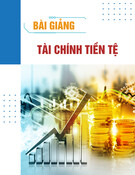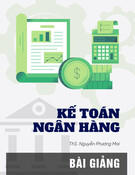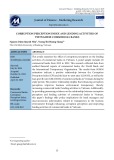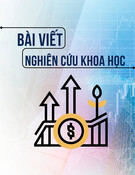
ISSN 1859-1531 - TẠP CHÍ KHOA HỌC VÀ CÔNG NGHỆ - ĐẠI HỌC ĐÀ NẴNG, VOL. 23, NO. 2, 2025 1
ADJUSTMENT BEHAVIOR OF CORPORATE CASH HOLDINGS:
EVIDENCE FROM VIETNAM
HÀNH VI ĐIỀU CHỈNH MỨC NẮM GIỮ TIỀN MẶT CỦA CÔNG TY:
BẰNG CHỨNG TỪ VIỆT NAM
Nguyen Quang Minh Nhi
The University of Danang - University of Economics, Vietnam
*Corresponding author: nhinqm@due.edu.vn
(Received: January 03, 2025; Revised: January 14, 2025; Accepted: Febuary 20, 2025)
DOI: 10.31130/ud-jst.2025.005E
Abstract - This paper examines the cash holdings behavior of
Vietnamese listed companies, focusing on whether a target cash
level exists that maximizes firm value and the speed at which
firms adjust towards this target. The study finds that the average
cash holding for these firms is approximately 10%. It reveals a
nonlinear relationship between cash holdings and firm value,
confirming the existence of an optimal cash level. Using pooled
OLS, Fixed Effects (FE), and Generalized Method of Moments
(GMM) models, the adjustment speed towards the target cash
level is estimated to be around 0.58. Vietnamese firms tend to
adjust their cash holdings more quickly during a financial crisis,
but more slowly during the COVID-19 pandemic. This research
contributes to the literature on cash holdings in emerging markets
and provides new insights into the speed of adjustment in
response to financial crises and the pandemic.
Tóm tắt – Bài báo nghiên cứu hành vi nắm giữ tiền mặt của các
công ty niêm yết tại Việt Nam, tập trung vào việc có tồn tại mức
tiền mặt mục tiêu tối đa hóa giá trị công ty và tốc độ điều chỉnh
về mức mục tiêu này. Kết quả chỉ ra mức tiền mặt trung bình của
các công ty khoảng 10%. Nghiên cứu phát hiện mối quan hệ phi
tuyến giữa tiền mặt và giá trị công ty, xác nhận sự tồn tại của một
mức tiền mặt tối ưu. Sử dụng các phương pháp hồi quy bình
phương bé nhất (Pooled OLS), Hiệu ứng cố định (FE) và hồi quy
mô-men tổng quát (GMM), tốc độ điều chỉnh về mức tiền mặt
mục tiêu ước tính là 0,58. Các công ty Việt Nam có xu hướng
điều chỉnh tiền mặt nhanh hơn trong thời kỳ khủng hoảng tài
chính, nhưng chậm hơn trong đại dịch COVID-19. Nghiên cứu
này đóng góp vào tài liệu nghiên cứu về nắm giữ tiền mặt tại các
thị trường mới nổi và cung cấp cái nhìn mới về tốc độ điều chỉnh
trong khủng hoảng tài chính và đại dịch.
Key words - Adjustment speed; cash holdings; COVID-19;
financial crisis; Vietnam
Từ khóa – Tốc độ điều chỉnh; nắm giữ tiền mặt; COVID-19;
khủng hoảng tài chính; Việt Nam.
1. Introduction
Cash and cash equivalents are vital assets for
businesses, offering liquidity to meet financial obligations
[1, 2]. However, excessive cash can lead to agency
problems, where managers focus on holding cash rather
than profitable investments, potentially causing negative
consequences for the company value [3]. Moreover, cash
investments yield lower returns than long-term assets,
creating an opportunity cost. While holding fewer cash
signals for efficient capital use, it can raise trading costs
due to insufficient funds for transactions. Therefore, firms
must balance cash holdings to avoid both liquidity issues
and inefficient capital use, aiming for an optimal level to
maximize value [4].
The literature focuses on the cash-holding decisions in
the US and corporations in developed countries. Yet, in the
Vietnamese market, the number of studies related to
corporate cash holdings behavior is still limited. Most
studies in Vietnam identify the determinants of cash ratio
as well as the relationship between cash holdings and firm
value [5-7]. Interestingly, Vietnamese firms hold higher
levels of cash reserves than firms in other countries.
Understanding Vietnamese firms’ cash-holding behavior,
therefore, is an interesting research question.
This study aims to extend the existing literature on cash
holding decisions by addressing the following key research
questions: (i) do Vietnamese firms have cash target levels,
and if so, how quickly do they adjust toward the targets?
(ii) Is there any change in their speeds of adjustment (SOAs
hereafter) toward these targets during the financial crisis
period and the COVID-19 pandemic?
To do so, firstly, the paper uses a panel of 650 listed
companies over the period 2006-2023 to observe the time
series properties of Vietnamese firms’ cash holdings.
Accordingly, Vietnamese listed firms hold around 10%
cash of total assets. Second, the research develops a
regression model and finds the existence of a nonlinear
relationship between cash holding and firm value, therefore
confirming an optimal cash level that maximizes firm
value. Third, the author estimates the speed at which firms
adjust their cash reserves towards the target. The overall
SOA for cash holdings is relatively high at 0.58 in
Vietnam, indicating that, on average, firms correct more
than half of their deviation from the target level within one
year. A high SOA is typically seen as evidence that firms
maintain a target level of cash holdings and consistently
adjust towards it, thus providing support for the trade-off
theory of cash holdings. Fourth, to the best of the author’s
knowledge, this is the first study to explore changes in the
SOA of cash holdings during the global financial crisis and
the COVID-19 pandemic in Vietnam. The findings reveal
that the SOA towards the target cash level was higher
during the global financial crisis but slower during the
COVID-19 pandemic, compared to periods unaffected by

2 Nguyen Quang Minh Nhi
such events. This insight enhances our understanding of
how economic crises influence corporate financing
decisions.
2. Literature review
2.1. Theoretical background
This section outlines three main theories explaining
cash holding decisions: trade-off, pecking order, and free
cash flow theories.
The trade-off theory suggests an optimal cash level that
balances the benefits of liquidity with the costs of holding
cash, such as opportunity, holding, and agency costs [2].
While cash provides liquidity and avoids external capital
costs, excessive cash can incur marginal costs. Firms adjust
their cash holdings toward a target level to maximize value
[4, 8-10], but adjustment may be prevented by costs like
information asymmetry and transaction costs [11]. Firms
with lower adjustment costs can make quicker changes.
Empirical research supports both the static trade-off theory
and the dynamic model of cash holdings [4, 10, 12-16].
Myers and Majluf [11]’s pecking order theory argues that
there is no optimal cash level for a company and suggests an
order of financing preferences. Instead, firms accumulate
cash to fund future investments due to information
asymmetry. Companies prefer internal resources over
external funding and debt over equity when raising capital
[11]. Therefore, holding a considerable amount of cash can
reduce the costs of raising funds externally, and serve
stockholders’ interests. Under this theory, firms are expected
to increase their cash holdings to preserve investment
opportunities during periods of crisis [17].
The free cash flow theory, proposed by Jensen [18],
argues that managers hold excess cash for personal
interests, often at the expense of shareholders. Harford et
al. [19] argue that cash accumulation can be used for
personal benefits or mismanagement, leading to missed
investment opportunities and inefficiencies. Excess cash
reduces the need for external funding and transparency,
which can negatively impact the company’s value. [3]
highlight that too much cash causes agency problems,
prompting shareholders to limit managers’ access to it.
Previous studies show that free cash flow influences
dividend policy, which in turn affects cash holdings [20,
21]. Similar to the pecking order theory, the agency theory
does not suggest an optimal level of cash for a company.
2.2. Empirical evidence on firms’ optimal cash holdings
and SOA towards target level
Previous studies confirm an optimal cash level
maximizes firm value, where the marginal cost of holding
cash equals its marginal benefit [22-24]. But this optimal
level varies across firms and different markets [25, 26].
The SOA to optimal cash holdings is crucial for firms,
as faster adjustments enhance liquidity stability and firm
value [4, 27, 28]. Numerous studies have explored optimal
cash levels and SOA in developed countries [25, 29, 30].
Amin and Williamson [31] find that Scandinavian firms
adjust cash levels quickly due to non-target costs and
precautionary motives, while Martínez-Sola et al. [32]
show that Spanish SMEs with greater growth opportunities
or financial distress adjust their cash levels faster,
especially during crises with credit constraints.
Recent studies have explored the impact of the global
financial crisis on cash holdings and SOA to optimal cash
levels. Ferreira and Vilela [25] suggest that cash helps
reduce financial distress and bankruptcy risk during difficult
financial periods. Other studies [19, 33] also believe that
cash holdings lower transaction costs and provide more
investment opportunities. However, financial distress and
capital market imperfections can delay adjustments to
optimal cash levels [10]. Martínez-Sola et al. [32] suggest
that firms in financial distress adjust cash holdings faster to
mitigate risks. Amin and Williamson [31] conclude that
smaller firms adjust cash holdings more quickly during a
crisis due to limited external financing. Batuman et al. [17]
observe a decline in adjustment speed for Eastern European
firms post-crisis, while Melgarejo and Stephen [34] report
faster adjustments in general, though multinational
corporations in Latin America adjust more slowly.
With the occurrence of COVID-19, Chung et al. [35]
report that the pandemic did not change firms’ cash
policies in Korea, but uncertainty and financial constraints
influenced decisions. In Latin America, Melgarejo and
Stephen [34] found faster adjustment speeds during the
pandemic as firms rushed to meet cash targets to reduce
risks. However, multinational corporations in this region
adjusted more slowly during the pandemic. Zhou et al. [33]
find that firms in China that are severely impacted by
COVID-19 have higher cash reserves.
In Vietnam, limited access to external funding makes
cash holdings vital for business operations and expansion.
During crises, firms accumulate more cash to improve
liquidity and flexibility [6]. Truong [36] identifies an
optimal cash level for Vietnamese firms, with most holding
more than this target. His study shows an adjustment speed
of 40.68% from 2010-2019, with faster adjustments for
firms with smaller discrepancies, higher free cash flow, or
financial deficits. However, it does not consider SOA
during the global financial crisis or COVID-19 pandemic.
3. Methodology
3.1. Data
The dataset includes non-financial firms listed on the
Vietnam Stock Exchange (HOSE and HNX) from 2006 to
2023. Firm data is collected from the FiinPro-X database.
Firms without complete financial reports, those that ceased
reporting, or those with missing key characteristics are
excluded. The final sample consists of 650 firms with
6,637 observations from 2006 to 2023.
3.2. Model
To examine whether there is an optimal cash holding
level, this study follows previous studies [22-24, 37] to
develop a non-linear model as follows:
Vi,t = β0 + β1Cashi,t +β2𝐶𝑎𝑠ℎ𝑖,𝑡
2+ β3Xi,t−1 + εi,t (1)
where Vi,t is the firm value of firm i at time t, which can
be measured as Tobin’s Q (Q) or Market-To-Book ratio
(MKBOOK). Cashi,t is the cash ratio of firm i at year t.

ISSN 1859-1531 - TẠP CHÍ KHOA HỌC VÀ CÔNG NGHỆ - ĐẠI HỌC ĐÀ NẴNG, VOL. 23, NO. 2, 2025 3
Xi,t is a set of firm characteristics for firm i at time t,
including Growth prospects (GROW), firm size (SIZE),
cash flow relative to assets (CF), net working capital
(NWC), leverage (LEV), dividend dummy (DIV) and
capital expenditure ratio (CAPEX). These control
variables are selected in line with previous research
[4, 22, 23, 38].
All variable definitions are provided in Appendix A.
Second, this study uses the partial adjustment model to
estimate how quickly a firm corrects deviations from its
target [14, 28].
∆Cashit = Cashit − Cashit−1
= γ ∗ (Cash∗it − Cashit−1) (2)
where Cash∗it is the target cash holdings of firm i at time t.
The Eq. (2) can be further re-arranged as:
Cashi,t = γCash∗i,t +(1 − γ)∗ Cashi,t−1 (3)
The target cash holdings (Cash∗it) cannot be directly
observed, so the fitted value of Eq. (4) is used as a proxy
for a target.
Cash∗i,t = βiXi,t−1 + 𝐹i,t (4)
From Eq. (3) and Eq. (4), the partial-adjustment model
is as follows:
Cashi,t =(1 − γ)𝐶𝑎𝑠ℎ𝑖,𝑡−1 + γβXi,t−1 + γ𝐹i,t + εit (5)
By estimating the coefficient of Cashi,t−1, the study can
extract the adjustment speed γ by subtracting the
coefficient from 1. A higher value of γ indicates faster
adjustment from the actual to the target level of cash.
4. Results
4.1. Variable summary
All descriptive statistics are reported in Table 1. As can
be seen, the average value of the Q ratio is 1.14, the average
MKBOOK is 1.24. The mean cash ratio is approximately
10%, which is comparable to the ratios observed for the US
(9.39% [15]) and UK (9.9% [12]). Additionally, the
average cash holdings to total assets ratio (10%) is higher
than the average cash flow to assets ratio (9.7%) and capital
expenditures to assets ratio (3.97%). Thus, cash holdings
constitute a non-trivial percentage of the total assets of
Vietnamese firms. This could be attributed to the higher
costs of obtaining external credit, which may force
Vietnamese firms to rely more on internal financing
compared to firms in other countries [16, 39].
Table 1. Summary statistics
Variable
Obs
Mean
Std. Dev.
Min
Max
Q
6,539
1.14
0.67
0.15
17.17
MKBOOK
6,539
1.24
1.38
0.00
61.67
CASH
6,637
0.10
0.11
0.00
0.96
GROW
6,633
0.10
0.23
-0.24
0.54
SIZE
6,637
27.24
1.55
23.22
32.87
CF
6,637
0.10
0.09
-0.90
0.94
NWC
6,637
0.23
0.23
-0.68
0.99
LEV
6,637
0.47
0.22
0.00
0.99
DIV
6,637
0.80
0.40
0.00
1.00
CAPEX
6,637
0.04
0.10
-2.28
0.92
Table 2 shows pairwise correlation coefficients
between variables. There is no significant pattern of
multicollinearity issues in this study.
Table 2. Correlation matrix
Variables
CASH
Q
MKBOOK
GROW
SIZE
CF
NWC
LEV
DIV
CAPEX
CASH
1
Q
0.151
1
MKBOOK
0.108
0.759
1
GROW
0.001
0.031
0.021
1
SIZE
-0.136
0.042
0.087
0.035
1
CF
0.247
0.388
0.231
0.153
-0.057
1
NWC
0.376
0.118
0.032
-0.064
-0.302
0.203
1
LEV
-0.255
-0.175
-0.062
0.106
0.314
-0.362
-0.656
1
DIV
0.161
0.120
0.073
-0.017
0.081
0.272
0.034
-0.015
1
CAPEX
-0.041
0.030
0.022
0.128
0.069
0.130
-0.145
0.058
0.061
1
4.2. Corporate cash holdings and firm value
Table 3 shows the estimated results of Eq. (1) using two
different proxies for firm value.
Table 3. Corporate cash holdings and firm value
Variables
Q
MKBOOK
Constant
-0.281
-1.862***
(-1.433)
(-3.966)
CASH
0.682***
1.741***
(2.941)
(4.367)
CASH2
-1.886***
-3.807***
(-3.311)
(-3.763)
GROW
-0.058*
-0.028
(-1.841)
(-0.345)
SIZE
0.038***
0.096***
(5.417)
(4.888)
LEV
-0.059
-0.037
(-1.012)
(-0.341)
DIV
0.030
-0.001
(1.280)
(-0.021)
CAPEX
-0.072
-0.149
(-1.148)
(-1.174)
CF
2.832***
3.565***
(15.122)
(10.200)
NWC
0.154***
0.109
(2.642)
(0.792)
Observations
6,539
6,539
R-squared
0.178
0.075
Year FE
YES
YES
Robust t-statistics are given in parentheses. ***, ** and * denote
significance at 1%, 5% and 10% levels, respectively.
As expected, the estimated coefficients of CASH are
positive and statistically significant whereas those of
CASH2 are significantly negative at the 1% level for both
proxies of firm value, suggesting a non-linear
relationship between cash holdings and firm value. This
result implies that cash holdings increase the value of the
firm up to the optimal point, beyond this point, cash
holdings would reduce the firm value. This finding also
confirms the existence of an optimal point in the
relationship between cash holdings and firm value in the
Vietnamese market.

4 Nguyen Quang Minh Nhi
4.3. Adjustment speed of cash holdings
Table 4 presents the SOA of cash holdings towards the
optimal level for Vietnamese companies using three
methods, including GMM, pooled OLS, and fixed-effects
(FE) estimations.
Table 4. Adjustment speed toward target cash level1
Variables
GMM
FE
OLS
Constant
0.090*
0.144**
0.061***
(1.897)
(2.034)
(2.707)
CASH
0.420***
0.370***
0.637***
(10.492)
(15.371)
(28.018)
Adjustment speed
0.580
0.630
0.363
GROW
0.007
0.005
0.005
(1.364)
(1.170)
(1.279)
SIZE
-0.002
-0.003
-0.002***
(-0.997)
(-1.269)
(-2.738)
LEV
-0.040***
-0.030**
-0.020***
(-3.731)
(-2.026)
(-2.741)
DIV
0.012***
-0.001
0.011***
(3.845)
(-0.296)
(4.432)
CF
0.035
0.058**
0.056***
(1.261)
(2.106)
(2.711)
NW
0.016
0.003
0.015**
(1.382)
(0.224)
(1.965)
CAPEX
-0.008
-0.023**
-0.020*
(-1.256)
(-2.273)
(-1.931)
Observations
6,637
6,637
6,637
R-squared
0.187
0.498
Adj. R-squared
0.184
0.496
Hansen J statistic
19.18
p-value of Hansen
statistic
0.206
Firm FE
YES
NO
Year FE
YES
YES
Standard errors are clustered at the firm level. Robust t-statistics
are given in parentheses. ***, ** and * denote significance at
1%, 5% and 10% levels, respectively.
The GMM procedure yields a coefficient of 0.42, which
corresponds to an SOA towards target cash holdings
of 0.58 (i.e., 1 – 0.42). The result indicates imperfect
adjustment because firms only close 58% of the gap
between current and optimal cash levels within one year.
This estimated adjustment speed is comparable to those for
US firms (i.e. 0.566 [10]) but it is slightly lower than those
found for UK firms (i.e. 0.605 [12]), which were obtained
using a similar estimation methodology. The relatively low
adjustment speed in Vietnam is due to higher adjustment
costs, which have resulted from the high liquidity risk,
significant information asymmetries problem, and frictions
that characterize the Vietnamese economy. It would
prevent Vietnamese firms from quickly moving their cash
reserves toward the target level.
Using pooled OLS, the SOA of cash holdings of 0.363,
1 For the robustness test, Net Cash = Cash/(Total assets - Cash) is used as an alternative measure of CASH variable.
The results remain unchanged. The author is thankful to the anonymous reviewer for this suggestion.
while a fixed-effects specification yields an adjustment
speed of cash holdings of 0.630. It has been shown that the
system GMM estimate (0.58) lies between the pooled OLS
estimate (lower bound) and the fixed-effects estimate
(upper bound). This pattern is consistent with the previous
studies [16]. Table 4 also shows that firms paying dividend
and cash flow tend to hold more cash whereas leverage
affects cash holdings negatively. These findings confirm
that Vietnamese firms actively adjust their cash holdings
toward the target optimal level, despite some lag in
rebalancing due to adjustment costs.
4.4. SOA towards optimal cash holdings level during the
global financial crisis and the COVID-19 pandemic
To capture the possible differences in the SOA during
the global financial crisis and the COVID-19 pandemic,
compared to the period without such events, the study
includes dummy variables for the events and an
interaction term between cash ratio and dummy variables.
Thus, this study modifies model (5) and develops the new
model:
Cashi,t =(1 − γ)𝐶𝑎𝑠ℎ𝑖,𝑡−1 + γβXi,t−1 + γ𝐹i,t
+β1𝐷𝑈𝑀𝑀𝑌 + β2DUMMY ∗ Cashit−1 + εit (6)
where, DUMMY is a dummy variable, which either equals
to 1 for the global financial crisis period (i.e, years 2008,
2009, 2010) or equals to 1 for the COVID-19 period
(i.e, years 2020, 2021) and otherwise, equals to 0 for the
other years.
Table 5. Adjustment speed toward target cash level:
global financial crisis and COVID-19
Variables
CRISIS
COVID-19
(1)
(2)
Constant
0.084***
0.060***
(3.710)
(2.689)
CASH
0.647***
0.628***
(26.634)
(26.422)
Adjustment speed
0.353
0.372
DUMMY
-0.015*
0.018**
(-1.862)
(2.130)
DUMMY*CASH
-0.078*
0.110**
(-1.877)
(2.443)
Observations
6,637
6,637
Controls
YES
YES
Year FE
YES
YES
Adj. R-squared
0.497
0.497
Standard errors are clustered at the firm level. Robust t-statistics
are given in parentheses. ***, ** and * denote significance at
1%, 5% and 10% levels, respectively.
Table 5 presents the estimation results of Eq. (6) to
examine the effect of the global financial crisis (column 1)
and the COVID-19 (column 2) on the SOA of cash
holdings. Control variables are included in each regression
but are suppressed for brevity.
The results show that the SOA difference between the

ISSN 1859-1531 - TẠP CHÍ KHOA HỌC VÀ CÔNG NGHỆ - ĐẠI HỌC ĐÀ NẴNG, VOL. 23, NO. 2, 2025 5
crisis and non-crisis periods is 0.078, significant at 10%.
This suggests firms adjust their cash holdings more quickly
during crises to avoid capital rationing and investment
reductions. Another reason for the higher SOA during the
crisis period is limited external financing and the need to
avoid financial distress [31]. Column (2) shows a
significantly positive coefficient on the COVID-19 dummy
variable (0.018), indicating firms hold more cash during
the pandemic. Additionally, the interaction between the
COVID-19 dummy and cash variable is positive (0.110)
and significant at 5%, suggesting firms adjust more slowly
to their optimal cash levels during COVID-19 compared to
non-COVID periods.
4.5. Robustness tests
For robustness tests, the study divides the sample into
two subsamples: firms during the global financial crisis
(2008-2010) and firms in the non-crisis period. The
research also splits the sample into three subsamples-
before, during, and after COVID-19-to assess the effect of
the pandemic on cash holding adjustments. Table 6 reports
the results.
Table 6. Robustness tests
Variables
Non-CRISIS
CRISIS
Pre-COVID
(2006-2019)
COVID-19
(2020-2021)
Post-COVID
(2022-2023)
(1)
(2)
(3)
(4)
(5)
Constant
0.074*
0.188**
0.136***
0.102**
0.152***
(1.737)
(2.485)
(2.836)
(2.431)
(2.968)
CASH
0.433***
0.364***
0.431***
0.672***
0.154*
(9.451)
(4.346)
(9.595)
(4.230)
(1.662)
Adjustment speed
0.567
0.636
0.569
0.328
0.846
Observations
5,815
822
4,740
906
991
Controls
YES
YES
YES
YES
YES
Hansen J statistic
12.06
7.462
13.18
0.314
0.0196
p-value of Hansen statistic
0.441
0.0240
0.282
0.575
0.889
Standard errors are clustered at the firm level. Robust t-statistics are given in parentheses. ***, ** and * denote significance at 1%,
5% and 10% levels, respectively.
In column (2), the coefficient of CASH is 0.364,
indicating an SOA of 0.636 during the global financial
crisis, compared to 0.567 for the non-crisis period. Both
coefficients are significant at the 1% level, confirming
faster cash adjustments during crises. The reduction in
bank credit during crises raises external financing costs
[40], prompting firms to hold more cash for transactional
and precautionary reasons. Faster cash adjustments thus
provide them with greater flexibility in managing their
finances during significant market fluctuations.
Moreover, the results show that the SOA of cash
holdings during the COVID-19 pandemic is slower than
in the pre- and post-pandemic periods. The lagged
dependent variable coefficient during COVID-19
(column 4) is 0.672, corresponding to an SOA of 0.328,
compared to 0.569 pre-COVID (column 3) and 0.846
post-COVID (column 5). This result is consistent with the
case of multinational corporations in Latin America [34].
Vietnamese firms have slower adjustment speeds during
the COVID-19 pandemic because of the high transaction
costs, higher liquidity risk, and then higher adjustment
costs, which prevent firms from quickly adjusting their
cash reserves towards the target level. Interestingly,
Vietnamese firms rebalanced their cash levels even
quicker after the pandemic, compared to before the
COVID-19 period. After the period of unexpected risk,
high uncertainty, and many difficulties with accessing
credit, firms may have felt more comfortable operating at
target cash levels. Therefore, they are likely to adjust their
cash holdings faster towards their target.
5. Conclusion
In this paper, the author examines the cash holdings
behavior of Vietnamese listed companies over the period
2006-2023. The study finds the nonlinear relationship
between cash ratio and firm value, suggesting the existence
of a target cash level that maximizes firm value. The
research contributes new insights into the optimal cash
level for Vietnamese firms. Additionally, the paper
identifies the overall SOA for cash holdings in Vietnam is
relatively high at 0.58, supporting the trade-off theory. This
finding enhances the existing literature on cash-holdings
behavior in Vietnamese companies. For the first time, the
paper shows that companies adjust their cash ratio toward
the target level more rapidly during the global financial
crisis, but at a slower pace during the COVID-19
pandemic, providing valuable insights into how cash
holdings respond to economic shocks that negatively
impact the economy.
The decisions regarding cash holdings and
adjustments toward the target cash level are largely
influenced by managerial decisions, especially during
times of economic uncertainty such as the global financial
crisis and the COVID-19 pandemic. However, this study
does not account for these managerial factors, which
limits its ability to fully explain the dynamics of cash
adjustment in response to these events. A natural
extension of the study would be to explore how manager
characteristics influence the pace of cash holdings
behavior and the rate at which firms adjust to their target
cash levels.


























